- Stay Connected
 Abraham Lincoln
If given the truth, the people can be depended upon to meet any national crisis...
Abraham Lincoln
If given the truth, the people can be depended upon to meet any national crisis...
 Guildford news...
for Guildford people, brought to you by Guildford reporters - Guildford's own news service
Guildford news...
for Guildford people, brought to you by Guildford reporters - Guildford's own news service
The Story of Stoughton Farm to Women’s Army Camp
Published on: 16 Jan, 2021
Updated on: 17 Jan, 2021
By David Rose
There was a time when the military had a strong presence in the Stoughton area of Guildford.
Stoughton Barracks, built in 1876, was the depot of the Queen’s Regiment until 1959, but continued to be used by the army until 1983. It is now the Cardwells Keep residential development.
At the end of Grange Road a women’s army camp was constructed during the Second World War, more of which later and some photos with an appeal for information of a person featured.
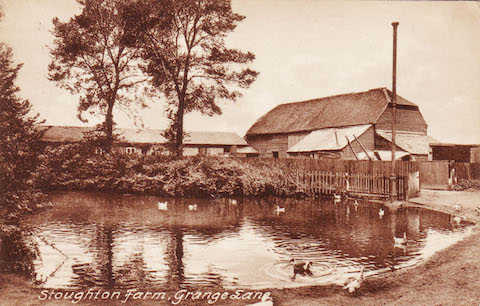
Stoughton Farm in Grange Lane in the 1900s and its 18th-century timber barn demolished in 2018. Note the tall cast-iron pipe to the right. It looks like a sewage vent or “stink pipe”, used to take away smelly noxious gases from sewers up into the air.
Today’s Grange Road was once known as Grange Lane. Towards the end of the lane was Stoughton Farm (later known as Grange Farm), with its historic 18th-century timber barn (demolished in April 2018 and replaced by houses, see previous story), and a duck pond.
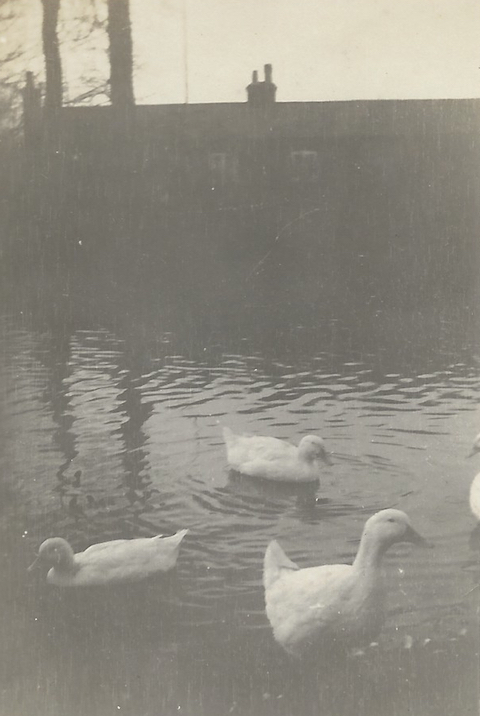
The duck pond at the farm. Picture: Butcher family collection.
The barn was on the left-hand side of Grange Road (coming from the direction of Stoughton Road), the farmhouse and other farm buildings were on the opposite side of the road.
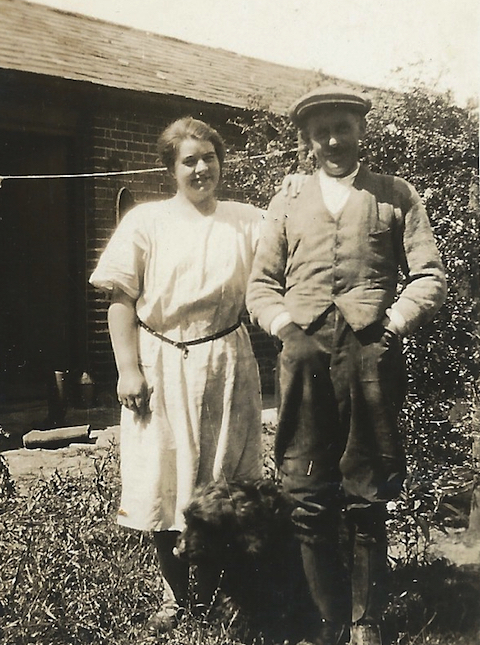
Dorothy and Albert Butcher who used the farm as a market garden. Picture: Butcher family collection.
The land had probably been farmed for centuries, but by 1924 it was little used. It was then bought by the Butcher family who used it for market gardening.
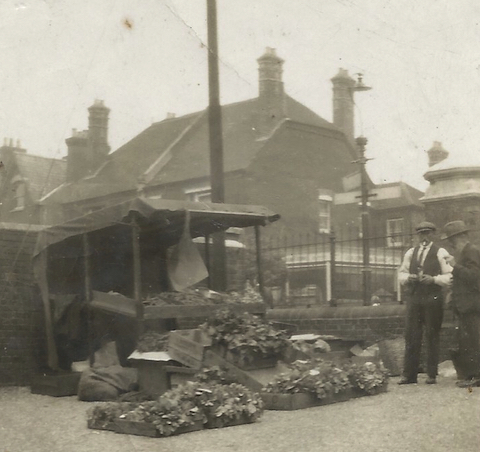
Farmer Albert Butcher’s stall at Guildford market (the cattle market in Woodbridge Road). Picture: Butcher family collection.
Dairying was carried out on the farm by the Burden family, who delivered milk to the local area by horse-drawn cart. In 1946 the Butchers sold what remained of the farm to the Burdens.
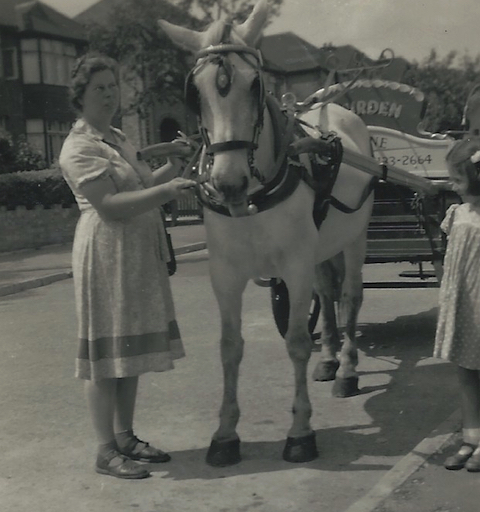
Burden’s milk delivery in the Stoughton area: Picture: Butcher family collection.
My mum, born in 1922 and raised in Stoughton, once told me how she and one of her sisters when quite young went on an “adventure” one day and ended up in the fields of the farm at the end of Grange Lane.
Farmer Butcher caught them and in no uncertain terms ordered them off his land. Evidently, he scared the life out of them and they quickly ran home!

Burden’s sold ice cream from both the farm and around the Stoughton area. Young John Butcher gets a ride on the ice-cream trike. Picture: Butcher family collection.
During the Second World War, a camp of wooden huts was built further to the north-west of the main part of the farm and used by the women’s Auxiliary Territorial Service (ATS), known as No.7 Training Centre, Queen’s Camp.

Pigs were kept as well. Picture: Butcher family collection.
These fields of the former farm may have been owned by someone other than the Butcher family and fruit trees were a feature of it.
However, according to the Butcher family, they received hardly any compensation from the military for the compulsory purchase of their land.
Albert Butcher had little paperwork to prove ownership, and besides, at the time of the compulsory purchase, the solicitor, who had drawn up the deeds for the Butchers when they purchased the land, had died and no records could be obtained. Also, Albert had to give up his land before he could harvest a large quantity of crops he had planted, which all went to waste!
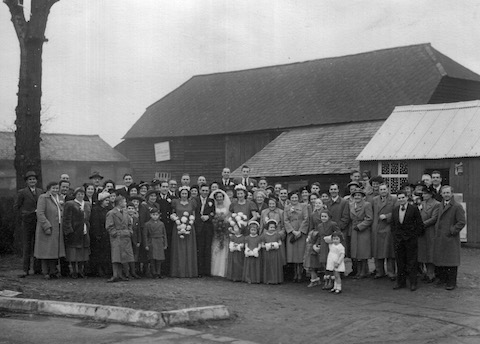
The barn and the café. Picture: Butcher family collection.
Also worth mentioning is the café that was beside the barn. This picture dates post-war and shows a wedding party. The bride is Ivy Taylor and the groom is Jack Green. Her wedding reception was held in the Hut Snack Bar there. It was later replaced by another café that was known as the Grange Road Café. It was run by Ivy’s father Steve, who had been a carter for Albert Butcher.
I recall the Grange Road Café, but I do not have any photos of it. If anyone has some, please get in touch, as I would love to see them and add them to this story!

A picture postcard view of the parade ground at the WRAC camp in Stoughton as it looked in about the late 1950s.
Back to the the ATS camp, and women received basic training that lasted for three weeks and then went to other military centres to learn specific trades and tasks for their time in the army.
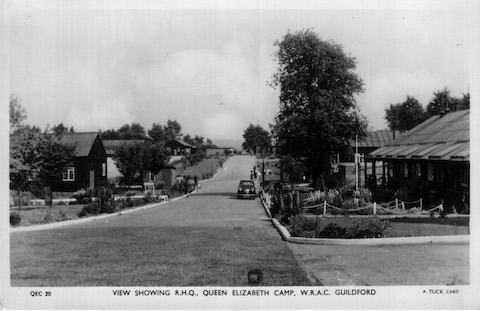
Another picture postcard view of the WRAC camp in Stoughton seen in about the late 1950s.
The camp was visited by Eleanor Roosevelt, the wife of the USA president in 1942.
In March 1945 it received a visit from the then Princess Royal, Mary, who was the sister of King George VI.
There are stories that the Queen, then Princess Elizabeth, did some of her training there, but that may not be true as I think I have read she did that at a similar camp in the Camberley area.
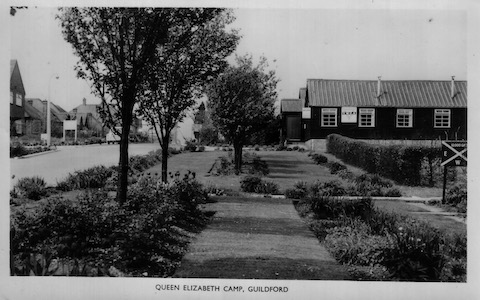
A view of the WRAC camp in Stoughton seen in about the late 1950s. This view also features a YMCA hut.
After the war, it continued to be an ATS training camp, while in 1949 the ATS was renamed the Women’s Royal Army Corps (WRAC).
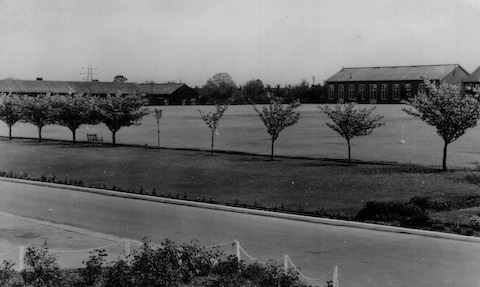
A view of the camp and the parade ground.
The camp at Stoughton was the home of the WRAC and in 1964 the wooden huts were demolished and a new camp built. It was then named the Queen Elizabeth Barracks. Us Stoughtonians usually referred to it as a camp and not a barracks!
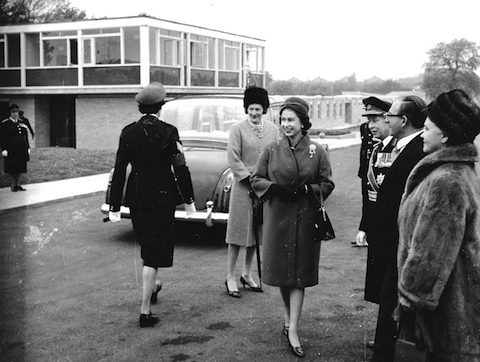
Press photo of the Queen’s visit in 1964 to open the new camp, named Queen Elizabeth Barracks.
The Queen visited to officially open the camp in 1964.
The Queen Mother was the WRAC’s Commandant in Chief and visited the camp several times, usually for special parades, and so on.
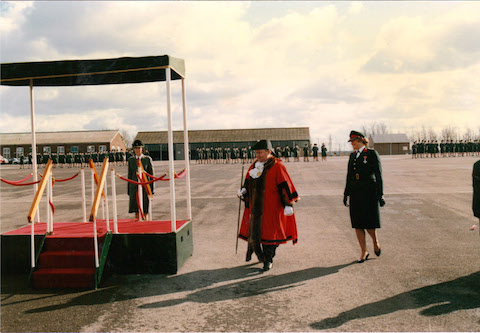
The now late Bernard Parke attending a parade at the camp when during his Guildford mayoral year (1989-90).
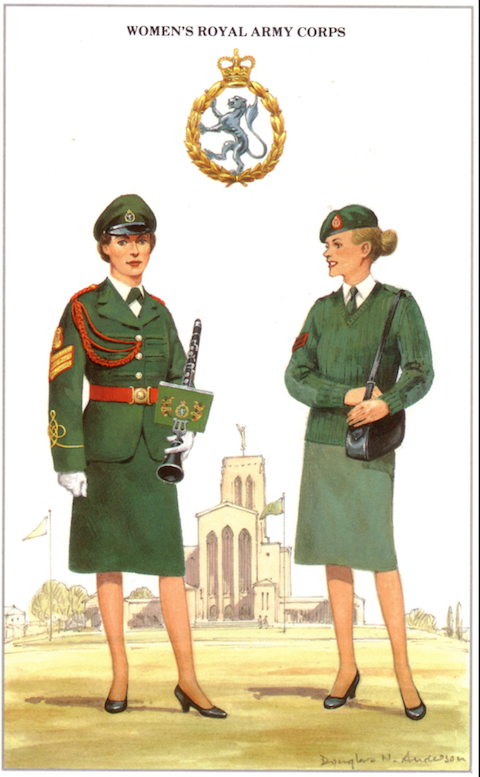
A modern picture postcard from a set of British regiments featuring the Women’s Royal Army Corps
The WRAC was disbanded in 1992, the camp closed and its remaining personnel were integrated into the army’s Adjutant General’s Corps.
It was, of course, all demolished for the Queen Elizabeth Park development that is there today and the road names are of former women officers of the WRAC.
Fiona Curtis has emailed these images and writes: “My late mother-in-law, Rose Curtis (nee McAlavey) joined the Women’s Royal Army Corps shortly after it was established.
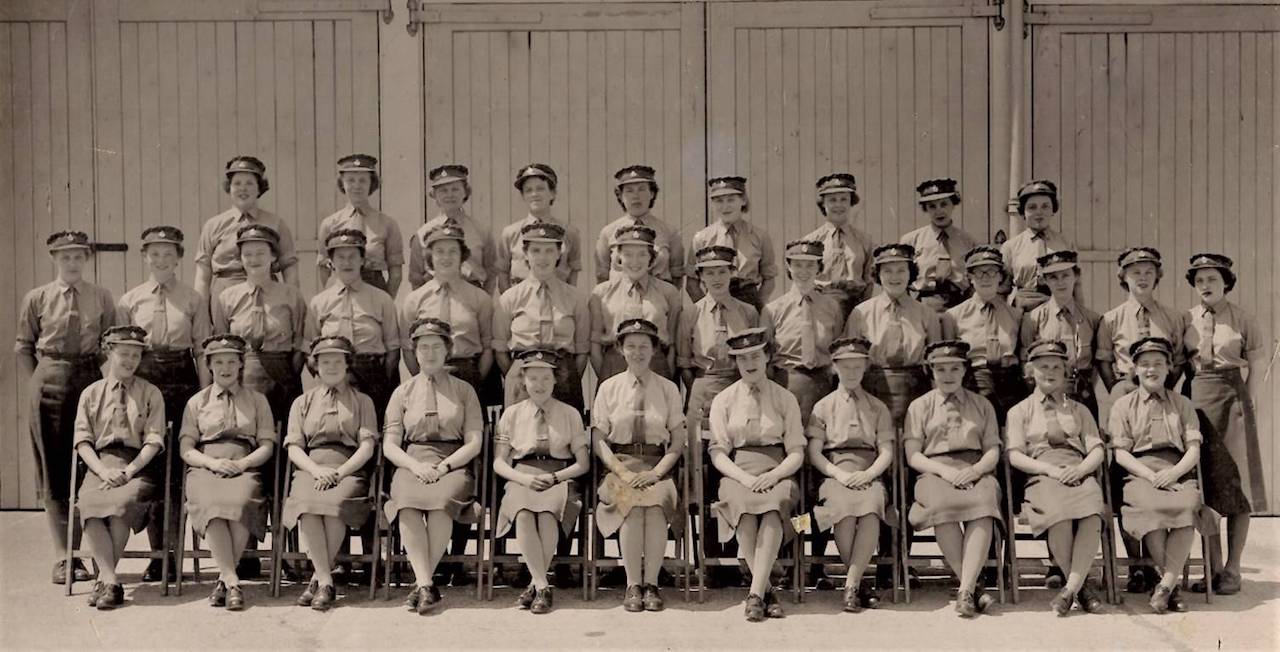
A group of women of the Women’s Royal Army Corps in 1951. Click on image to enlarge in a new window.
“These images were taken [at Stoughton] in 1951. Rose had vibrant auburn hair and was known as ‘Ginger’. As is traditional on a group photograph, everyone signed it.
“If anyone knew Rose or has memories of these early days of the WRAC, I would love to hear from them as I recently did a family history and all information is valuable.”
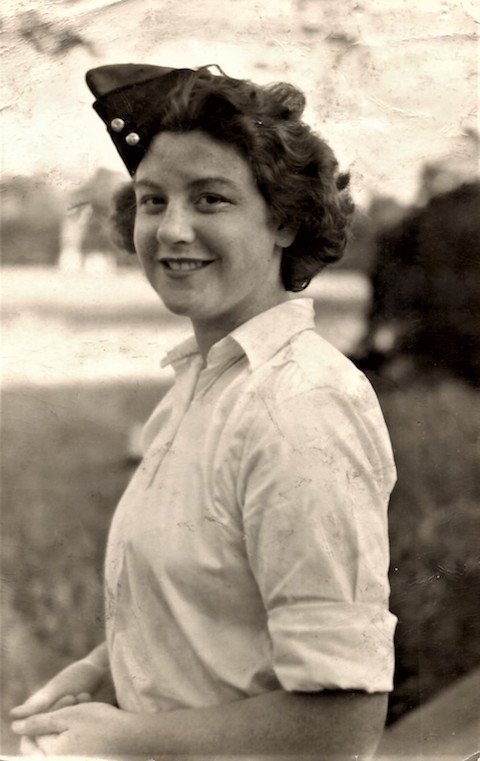
Rose McAlavey (her maiden name) was in the Women’s Royal Army Corps in the 1950s.
If you can help email Fiona at fionacurtis@btinternet.com
I have also added Fiona’s appeal to a previous story on The Guildford Dragon News – Memories Of Queen Elizabeth Barracks And The Women’s Royal Army Corps.
This story, the memories of a former WRAC, Angela Rose (no relation to me), was first published in 2015. Since then it has had 180 comments published.
It surely must come up when former WRACs search the internet looking for information on the camp/ barracks in Stoughton and is used to try and trace long-lost army friends.



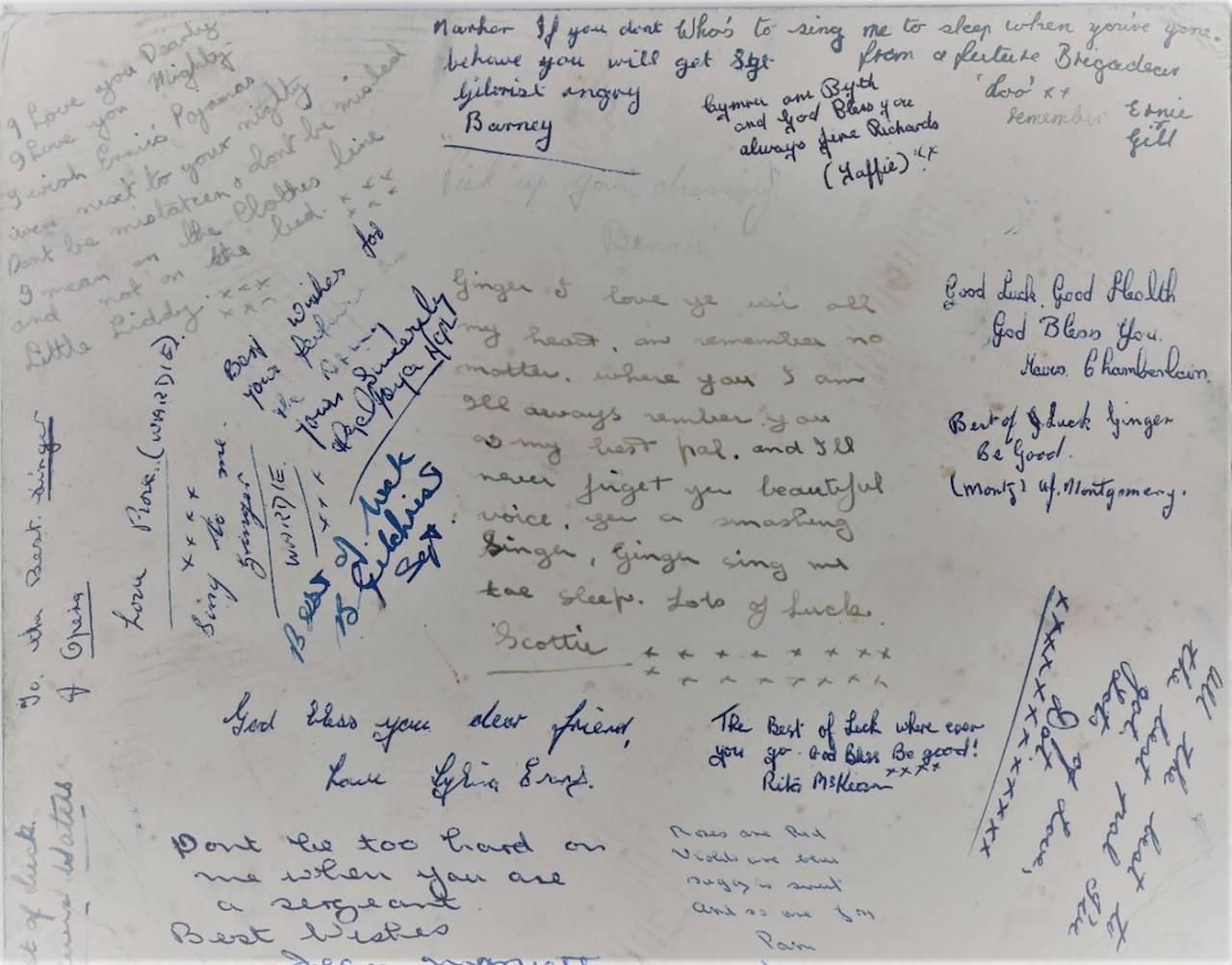














Jan Messinger
January 16, 2021 at 4:38 pm
David Rose as always a very interesting read with fabulous photographs. I always lookout for the history pieces. However, I think the readers have so many wonderful articles to read. Guildfordians can’t say they don’t know what’s going on today, as well as the past, if they look each day at the Guildford Dragon NEWS online.
Plus they can support the Guildford lions and sign up for David’s Zoom history talk on 20 January, after all not many people’s diaries are full at the moment.
Fiona Curtis
January 20, 2021 at 11:46 pm
Thanks for the reminder about the history talk by David Rose. I was lucky and managed to grab a ticket. Great turn out (close on 100 I think) and great talk.
It was a good night in!
Rex Cranstone
January 22, 2021 at 3:35 pm
Yes, I remember them well. We used to get our milk delivered by horse and cart with the lady in the picture. Also used to get ice cream on our way home to Belmont Avenue from Northmead school where I used to go 1950-1959. So long ago.
I now live in Nottinghamshire and Portugal.
John Lomas
January 22, 2021 at 6:22 pm
The style of the houses and the angle of the shadows has me thinking that the photo of the horse and trap was taken on the lower parts of Sheepfold Road, Byrefield Road or Belmont Avenue.
Aubrey Leahy
January 23, 2021 at 8:59 pm
Even though I am reading this from 5,400 miles and 65 years away I have instantly recalled the delicate aroma of fried onions being slathered on a hotdog from the cafe and became ravenous.
Jean Barnes-Harvey
March 27, 2021 at 7:45 pm
I was interested to find this article as I joined the WRAC in 1966 aged 17 and did my basic training at the Queen Elizabeth Barracks. After I had ‘passed out’ I was unable to proceed immediately to my first posting at Ty Croes in Anglesey – the test firing range for Thunderbird missiles. I had to wait for several other girls on a later basic training course to join me.
During that time I worked at the Map Depot which was situated just along the road outside of the barracks. I spent several happy months there and particularly remember a very kind lady – I’ve since forgotten her name – who took me under her wing and taught me how to do the necessary paperwork to send maps which had been ordered by Army units all over the world.
The lady I worked with was a very keen amateur ballroom dancer who had won many awards. It was lovely to hear her stories and I still remember her today, particularly when watching Strictly Come Dancing.